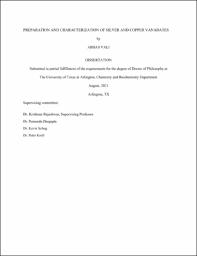| dc.description.abstract | Combining two or more binary compounds to generate a multinary compound is a viable strategy to improve the performance and properties of the parent binary compounds. In this vein, multinary compound semiconductors have recently come under the spotlight for a variety of practical device applications. In particular, the low band gaps of the Ag-V-O ternary family (Ag3VO4, Ag4V2O7, AgVO3, Ag2V4O11, and AgV7O18) and Cu(II)-V-O ternary family (CuV2O6, Cu2V2O7, Cu3V2O8, Cu11V6O26, and Cu5V2O10) have recently garnered interest. These visible light active semiconductors may be used for photovoltaic solar cells, solar water splitting, CO2 photoreduction, and photocatalytic remediation applications. In particular, AgVO3 and Ag3VO4 and Cu2V2O7 have attracted considerable interest for use as semiconductors for heterogeneous photocatalysis and water splitting processes.
Solar energy conversion applications need large active area films. Therefore, preparation techniques that are compatible with direct synthesis of semiconductor thin films, are attractive. In this vein, electrochemical deposition is a fast, low temperature, and scalable process candidate. Therefore, for the first time, I successfully developed a two-step electrosynthesis technique for synthesizing AgVO3, Ag3VO4, and CuVO3 thin films on a conducting substrate. Interestingly, the as-prepared silver vanadates (AgVO3 and Ag3VO4) were crystalline. On the other hand, the electrodeposited CuVO3 thin films were unstable and amorphous. Adding a thermolysis step to electrosynthesis process converted CuVO3 to β-Cu2V2O7. Therefore, an electrothermodeposition (ETD) strategy was developed as a versatile route for synthesizing multinary oxide thin films. Subsequently, we evaluated the optoelectronic behavior, semiconductor electronic band structure, thermal/electrochemical stability, and electrochemical/photoelectrochemical attributes of these new-generation semiconductors. | |


